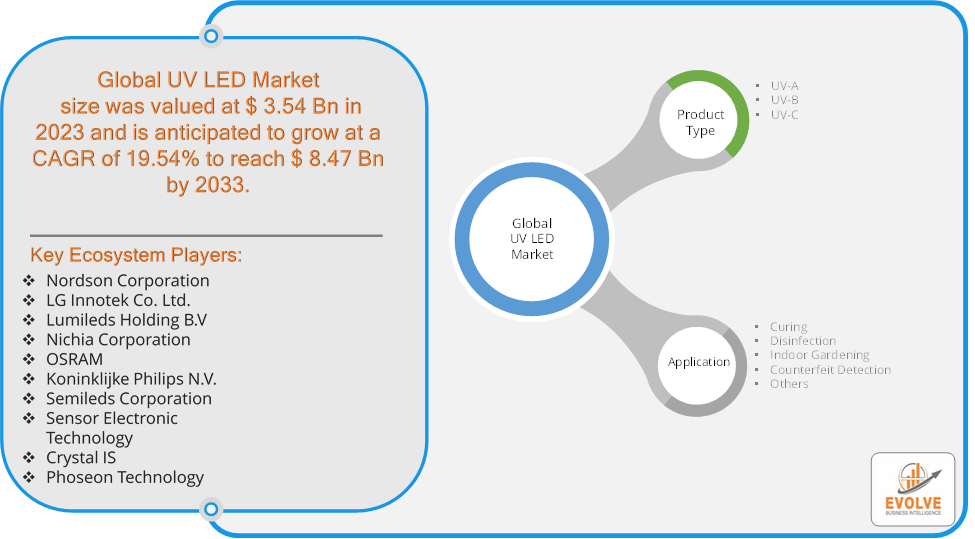Evolve Business Intelligence has published a research report on the Global UV LED Market, 2023–2033. The global UV LED Market is projected to exhibit a CAGR of around 19.54% during the forecast period of 2023 to 2033.
Evolve Business Intelligence has recognized the following companies as the key players in the global UV LED Market: Nordson Corporation, LG Innotek Co. Ltd, Lumileds Holding B.V,Nichia Corporation, OSRAM, Koninklijke Philips N.V, Semileds Corporation, Sensor Electronic Technology, Crystal IS and Phoseon Technology.
 More Information: https://evolvebi.com/report/uv-led-market-analysis/
More Information: https://evolvebi.com/report/uv-led-market-analysis/
Market Highlights
The Global UV LED Market is projected to be valued at USD 8.47 Billion by 2033, recording a CAGR of around 19.54% during the forecast period. The UV LED market encompasses the production, development, and sale of ultraviolet light-emitting diodes (UV LEDs). The UV LED Market refers to the global market for ultraviolet (UV) light-emitting diodes (LEDs), which are semiconductor devices that emit light in the ultraviolet spectrum when an electric current passes through them.
The market is driven by the increasing demand for energy-efficient lighting solutions, the growing adoption of UV-C LEDs for disinfection, and the replacement of traditional mercury-based UV lamps. The UV LED market is segmented by type (UV-A, UV-B, UV-C), application, end-user industry, and geography. Key factors influencing the market include technological advancements, regulatory standards for safety, and environmental concerns related to mercury usage in traditional UV lamps.
The COVID-19 pandemic had a significant impact on the UV LED Market. The pandemic led to a heightened focus on hygiene and sanitation, driving an increased demand for UV-C LEDs, which are effective in inactivating viruses, bacteria, and other pathogens. UV-C LED technology was rapidly adopted for disinfecting air, water, and surfaces in public spaces, hospitals, transportation systems, and even households. The need for effective disinfection solutions spurred innovation and the development of new products, such as portable UV-C sterilizers, UV-C robots, and UV-C air purifiers, incorporating UV LEDs. This broadened the market’s application scope. As the pandemic progressed, companies began to mitigate these challenges by diversifying their supply chains, increasing local production, and stockpiling critical components to ensure business continuity. The rapid deployment of UV-C LED products also highlighted the need for clear safety standards and guidelines to prevent improper use and ensure consumer safety. This spurred regulatory bodies and industry players to collaborate on developing and promoting such standards. The pandemic raised global awareness of UV LED technology, leading to increased interest and adoption in regions and industries that were previously less exposed to the technology.
Segmental Analysis
The global UV LED Market has been segmented based on Product Type and Application.
Based on Product Type, the UV LED Market is segmented into UV-A, UV-B and UV-C. The UV-C segment is anticipated to dominate the market.
Based on Application, the global UV LED Market has been divided into the Curing, Disinfection, Indoor Gardening, Counterfeit Detection and Others. The Disinfection segment is anticipated to dominate the market.
More Information: https://evolvebi.com/report/uv-led-market-analysis/
Regional Analysis
The UV LED Market is divided into five regions: North America, Europe, Asia-Pacific, South America, and the Middle East, & Africa. North America, particularly the United States and Canada, is a leading region in the UV LED market due to its advanced technology infrastructure and high adoption rates in disinfection and sterilization applications. The region benefits from significant R&D investments and strong demand for UV-C LEDs in healthcare, public spaces, and commercial applications. Europe is experiencing robust growth in the UV LED market, driven by stringent environmental regulations and the European Union’s focus on sustainable and energy-efficient technologies. The market benefits from significant investments in healthcare and industrial applications. The Asia-Pacific region is one of the fastest-growing markets for UV LEDs, driven by rising industrialization, urbanization, and increasing awareness of health and hygiene. Key markets include China, Japan, South Korea, and India. The region sees substantial growth in UV LED applications for industrial curing, air and water purification, and consumer products, fueled by economic development and increasing investment in infrastructure. The UV LED market in Latin America is still developing but shows potential for growth, particularly in applications like water treatment and healthcare. Countries such as Brazil and Mexico are leading the market, with increasing investments in infrastructure and technology. The Middle East and Africa region is experiencing gradual growth in the UV LED market, driven by increasing awareness of health and sanitation and investments in infrastructure development. Key markets include the UAE, South Africa, and Saudi Arabia.